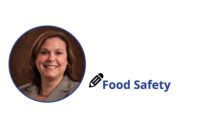Ever since Frank Yiannas of Walmart’s Food Safety Leadership published his insightful book “Food Safety Culture” in 2008, the food and beverage industry has embraced the reality that having a strong food safety culture is essential for success. While executives and managers across the industry accept the necessity of having a strong culture, they have struggled with the best ways to measure it. We must now look at behavioral science.
When we look at what it takes to impact food safety beliefs and behaviors, many of the necessary elements already align with current food safety best practices and audit standards. The three paramount factors that impact food safety culture are: management commitment, food safety management systems, and communication and education.
Management commitment to food safety goes beyond believing that food safety is a priority. It involves very specific behaviors, which can be measured. At the individual site level, one sign of a commitment to food safety is the degree to which the plant manager interacts with the front-line personnel. A sign of positive culture is a plant manager who visits the factory floor each day and covers all shifts, including graveyard shifts and sanitation/maintenance shifts during “down time” at least once per week.
Financial investments made by management also impact culture. These investments include giving employees a nice environment to work in—one that everyone wants to maintain. We recognize that food processing facilities can have some unpleasant traits such as extreme temperatures and high noise levels, but if they are well-maintained, a sense of pride becomes instilled in the staff. Things like roof leaks, damaged floors and walls, and deteriorated insulation are not only food safety risks, but they also put culture at risk. In a poorly maintained building, the mentality becomes, “If management doesn’t care, why should we?”
Within the food safety management system, the three key components that will impact food safety culture are risk awareness, defined procedures and continuous improvement. “Risk awareness” and “risk-based” are terms that have grown in prevalence in the food industry in the last decade. To develop policies and procedures and to make real-time decisions about food safety, personnel must understand the science behind food safety risks and then be able to apply critical thinking skills to individual events to make sound decisions. If food safety training for personnel includes only the company-established policies and procedures and not the “why” behind them, employees do not learn how to assess risk. For example, something as simple as explaining what food safety risk is mitigated when hands are washed may help reinforce re-washing hands after touching surfaces such as pallets or one’s own face. To measure this element, an organization should assess the training materials used with employees and interview the employees to see if they can articulate the risks that are managed by their behaviors.
Risk awareness training for employees must also differentiate between quality and food safety. This is particularly applicable for employees involved in determining the disposition of non-conforming product that has been put on hold. While both quality and food safety issues may lead to complaints, the severity of the food safety issue must be part of the analysis. For example, a snack food on hold for uneven distribution of seasoning is a quality issue. If that same snack food is on hold because there is a concern of an undeclared allergen, that’s a food safety issue. While quality is important to the business, it has less-severe consequences than a food safety issue. A measurement of culture in this regard is an evaluation of the process used to determine disposition of held product. If food safety risks are considered non-negotiable as part of this decision-making process, this is an indicator of a successful culture.
A well-developed food safety management system will have clearly defined policies and procedures. If the goal of a strong food safety culture is a shared set of values, beliefs and behaviors, the foundation will be that all staff agree to the same sets of practices. The other element of culture that is addressed by well-defined policies and procedures is role clarity. With role clarity, the chances for an issue to go unidentified and unaddressed are significantly reduced. To measure this element of food safety climate, a comprehensive interview process with employees, to compare their understanding to what is in the documented management system, will be invaluable.
Finally, the food safety management system must have a mechanism to measure food safety results and to take steps toward continuous improvement. Typical measurements of food safety results include measurement of recalls, food safety complaints, food safety holds, rework, re-cleaning and environmental results. In measuring food safety climate, the question would be whether the organization has an effective way to measure food safety failures and if meaningful actions are taken to prevent recurrence.
Like any other business success, food safety success requires that all employees work toward the common goal. An essential component to achieving this is an abundance of valuable communication and employee-centric education. Shared values and beliefs come from a sense of belonging within a community, which is fostered through effective communication—however, this communication must go beyond food safety issues. Employees like to be “in the know.” For example, if a site is having a new silo installed, it’s likely that many employees have been involved in the planning and some who are directly impacted have likely been told of the project. However, there is value in letting everyone know what is happening in their community rather than having employees show up to work one day and seeing some sort of construction project going on but not knowing any details.
Communication includes positive channels for communication in many directions, including from management to employees, from front-line employees to management, and cross-departmental channels. Unfortunately, it is common for there to be friction between departments in a food plant. This friction can only erode the food safety culture, which aims to create a team of people with shared values and beliefs.
Finally, education is critical to establishing a strong food safety culture. This includes ensuring that personnel understand the policies and procedures that are relevant for their job function, the rationale behind those procedures (what risks are being mitigated), an explanation of the “big picture” and how they fit in it, the authority given to employees to intervene if there is a concern about food safety, and ongoing information about the organization’s performance regarding food safety.




